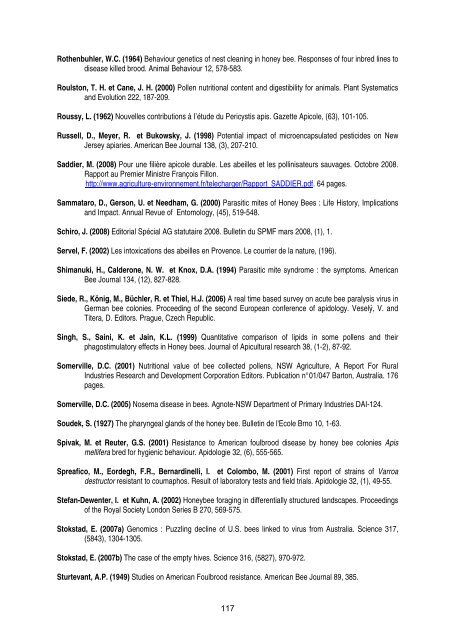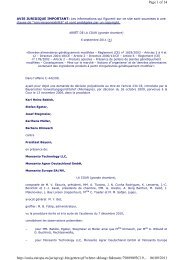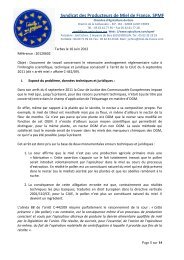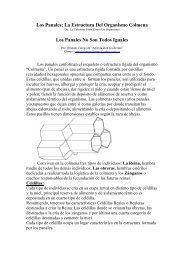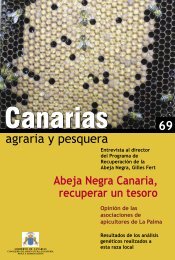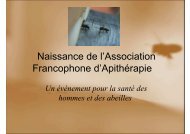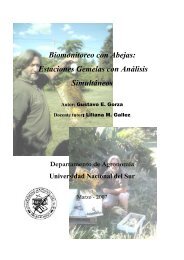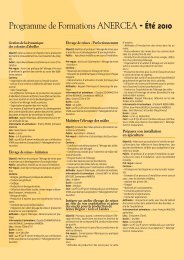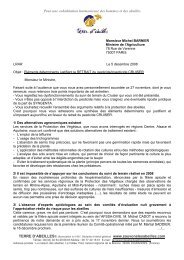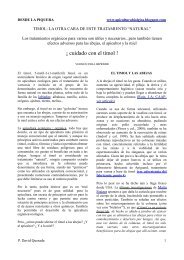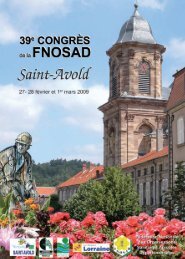Rothenbuhler, W.C. (1964) Behaviour gen<strong>et</strong>ics of nest cleaning in honey bee. Responses of four inbred lines todisease killed brood. Animal Behaviour 12, 578-583.Roulston, T. H. <strong>et</strong> Cane, J. H. (2000) Pollen nutritional content and digestibility for animals. Plant Systematicsand Evolution 222, 187-209.Roussy, L. (1962) Nouvelles contributions à I’étude du Pericystis apis. Gaz<strong>et</strong>te Apicole, (63), 101-105.Russell, D., Meyer, R. <strong>et</strong> Bukowsky, J. (1998) Potential impact of microencapsulated pestici<strong>des</strong> on NewJersey apiaries. American Bee Journal 138, (3), 207-210.Saddier, M. (2008) Pour une filière apicole durable. Les abeilles <strong>et</strong> les pollinisateurs sauvages. Octobre 2008.Rapport au Premier Ministre François Fillon.http://www.agriculture-environnement.fr/telecharger/Rapport_SADDIER.pdf. 64 pages.Sammataro, D., Gerson, U. <strong>et</strong> Needham, G. (2000) Parasitic mites of Honey Bees : Life History, Implicationsand Impact. Annual Revue of Entomology, (45), 519-548.Schiro, J. (2008) Editorial Spécial AG statutaire 2008. Bull<strong>et</strong>in du SPMF mars 2008, (1), 1.Servel, F. (2002) Les intoxications <strong>des</strong> abeilles en Provence. Le courrier de la nature, (196).Shimanuki, H., Calderone, N. W. <strong>et</strong> Knox, D.A. (1994) Parasitic mite syndrome : the symptoms. AmericanBee Journal 134, (12), 827-828.Siede, R., König, M., Büchler, R. <strong>et</strong> Thiel, H.J. (2006) A real time based survey on acute bee paralysis virus inGerman bee <strong>colonies</strong>. Proceeding of the second European conference of apidology. Veselý, V. andTitera, D. Editors. Prague, Czech Republic.Singh, S., Saini, K. <strong>et</strong> Jain, K.L. (1999) Quantitative comparison of lipids in some pollens and theirphagostimulatory effects in Honey bees. Journal of Apicultural research 38, (1-2), 87-92.Somerville, D.C. (2001) Nutritional value of bee collected pollens, NSW Agriculture, A Report For RuralIndustries Research and Development Corporation Editors. Publication n°01/047 Barton, Australia. 176pages.Somerville, D.C. (2005) Nosema disease in bees. Agnote-NSW Department of Primary Industries DAI-124.Soudek, S. (1927) The pharyngeal glands of the honey bee. Bull<strong>et</strong>in de l'Ecole Brno 10, 1-63.Spivak, M. <strong>et</strong> Reuter, G.S. (2001) Resistance to American foulbrood disease by honey bee <strong>colonies</strong> Apismellifera bred for hygienic behaviour. Apidologie 32, (6), 555-565.Spreafico, M., Eordegh, F.R., Bernardinelli, I. <strong>et</strong> Colombo, M. (2001) First report of strains of Varroa<strong>des</strong>tructor resistant to coumaphos. Result of laboratory tests and field trials. Apidologie 32, (1), 49-55.Stefan-Dewenter, I. <strong>et</strong> Kuhn, A. (2002) Honeybee foraging in differentially structured landscapes. Proceedingsof the Royal Soci<strong>et</strong>y London Series B 270, 569-575.Stokstad, E. (2007a) Genomics : Puzzling decline of U.S. bees linked to virus from Australia. Science 317,(5843), 1304-1305.Stokstad, E. (2007b) The case of the empty hives. Science 316, (5827), 970-972.Sturtevant, A.P. (1949) Studies on American Foulbrood resistance. American Bee Journal 89, 385.117
Suard , T. (2008) Thymovar, une solution simple, efficace <strong>et</strong> naturelle contre la varroase. Abeilles&Cie, (122),35.Synge, A.D. (1947) Pollen collection by honeybees. Journal of Animal Ecology 16, 122-136.Tardieu, V. (1998) Les apiculteurs accusent le Gaucho d'empoisonner leurs abeilles. Le Monde du 18 avril1998.Tautz, J., Maier, S., Groh, C., Rossler, W. <strong>et</strong> Brockmann, A. (2003) Behavioral performance in adult honeybees is influenced by the temperature experienced during their larval development. Proceedings of theNational Academy of Science U S A 100, (12), 7343-7347.Tentcheva, D., Gauthier, L., Zappulla, N., Dainat, B., Cousserans, F., Colin, M.E., <strong>et</strong> al. (2004) Prevalenceand seasonal variations of six bee viruses in Apis mellifera L. and Varroa <strong>des</strong>tructor mite populations inFrance. Applied and Environmental Microbiology 70, (12), 7185-7191.Thomas, M.C. (1998) Pest alert : small hive be<strong>et</strong>le. American Bee Journal 138, (8), 565.Thompson, H.M., Brown, M.A., Ball, R.F. <strong>et</strong> Bew, M.H. (2002) First report of Varroa <strong>des</strong>tructor resistance topyr<strong>et</strong>hroids in the UK. Apidologie 33, (4), 357-366.Todd, J.H., De Miranda, J.R. <strong>et</strong> Ball, B.V. (2007) Incidence and molecular characterization of viruses found indying New Zealand honey bee (Apis mellifera) <strong>colonies</strong> infested with Varroa <strong>des</strong>tructor. Apidologie 38,(4), 354-367.Toma, B., Bén<strong>et</strong>, J.-J., Dufour, B., Eloit, M., Moutou, F. <strong>et</strong> Sanaa, M. (1991) Glossaire d'épidémiologieanimale, Editions du point vétérinaire. Maisons-Alfort. 365 pages.Trouiller, J. (1998) Monitoring Varroa jacobsoni resistance to pyr<strong>et</strong>hroids in western Europe. Apidologie 29, (6),537-546.Unsworth, J.B., Wauchope, R.D., Klein, A.W., Dorn, E., Zeeh, B., Yeh, S.M., <strong>et</strong> al. (1999) Significance of thelong range transport of pestici<strong>des</strong> in the atmosphere (technical report). Pure and Applied Chemistry 71,(7), 1359-1383.Vallon, J., Savary, F., Jourdan, P. <strong>et</strong> Clair, V. (2006) Essai de l'intérêt de l'association du thymol <strong>et</strong> de l'acideoxalique pour la maîtrise de la varroatose en Provence. Bull<strong>et</strong>in Technique Apicole 33, (4), 163-168.Vallon, J., Savary, F. <strong>et</strong> Jourdan, P. (2007) Suivi de l'efficacité <strong>des</strong> traitements contre Varroa <strong>des</strong>tructorbénéficiant d'une AMM au cours de l'automne <strong>et</strong> l'hiver 2006/2007. Bull<strong>et</strong>in Technique Apicole 34, (2),49-54.Vanengelsdorp, D., Underwood, R., Caron, D. <strong>et</strong> Hayes, J. (2007) An estimate of managed colony losses inthe winter of 2006-2007 : a report commissioned by the apiary inspectors of America. American BeeJournal 147, (7), 599-609.Vear, F. , Pham-Delègue, M. H., Tourvieille De Labrouhe, D., Marilleau, R., Loublier, Y. , Le M<strong>et</strong>ayer, M., <strong>et</strong>al. (1990) Gen<strong>et</strong>ical studies of nectar and pollen production in sunflower. Agronomie 10, (3), 219-231.Villemand, C., Haxaire, J. <strong>et</strong> Straito, J.C. (2006) La découverte du frelon asiatique Vespa velutina, en France.Insectes 143, (4), 3-7.Vincent,C., (2007) Interviews : Bernard Vaissière s’exprime à propos <strong>des</strong> conséquences de la disparition <strong>des</strong>abeilles. In : Le monde du 14 octobre 2007. 8 pages. Consultable en ligne à l'adresse suivante :http://www.museum.agropolis.fr/pages/savoirs/apiculture_raisonnee/LEMONDE20071014_Vaissiere.pd118
- Page 1:
Mortalités, effondrements et affai
- Page 4 and 5:
M. François MOUTOUEpidémiologie g
- Page 6 and 7:
SOMMAIRELISTE DES TABLEAUX ........
- Page 9:
RÉFÉRENCES BIBLIOGRAPHIQUES......
- Page 16 and 17:
INTRODUCTIONL’environnement et l
- Page 18 and 19:
Les membres de ce groupe de travail
- Page 20 and 21:
Figure 1 : Population théorique mo
- Page 22 and 23:
Figure 2 : Facteurs influençant l
- Page 24 and 25:
Pour le calcul du taux de mortalit
- Page 26 and 27:
Agent pathogèneVespa velutinaAethi
- Page 28 and 29:
Tableau 3 : Les douze principaux vi
- Page 30 and 31:
1.2.2 Agents chimiquesLes abeilles
- Page 32 and 33:
• L’exposition résultant de l
- Page 34 and 35:
- Au Royaume-Uni, d’après le WII
- Page 36 and 37:
Par leur nature, ces types d’inci
- Page 38 and 39:
Le taux de protéine contenu dans l
- Page 40 and 41:
Tableau 4 : Teneur en protéines br
- Page 42 and 43:
1.2.3.4 Pratiques agricolesÉvoluti
- Page 44 and 45:
En conditions de laboratoire, semi-
- Page 46 and 47:
- des conditions climatiques, alter
- Page 48 and 49:
2 SITUATION SANITAIRE DE LA FILIÈR
- Page 50 and 51:
2.2 LA FILIERE APICOLE FRANÇAISE2.
- Page 52 and 53:
2.2.2 Les difficultés de la filiè
- Page 54 and 55:
2.3 CAUSES DES MALADIES DES ABEILLE
- Page 56 and 57:
2.3.1.2 Publications et rapports sc
- Page 58 and 59:
Une étude consacrée aux viroses d
- Page 60 and 61:
2.3.2.2 Publications et rapports sc
- Page 62 and 63:
Des cas de mortalités anormales d
- Page 64 and 65:
Les informations disponibles pour l
- Page 66 and 67:
aux colonies, même si, en théorie
- Page 68 and 69: A l’issue de l’étude des cause
- Page 70 and 71: Figure 3 : Organisation des structu
- Page 72 and 73: Toutefois, pour plusieurs raisons,
- Page 74 and 75: Plus particulièrement dans le doma
- Page 76 and 77: 2.4.1.4 Rôle de la professionDiff
- Page 78 and 79: 2.4.1.5 La formation sanitaire apic
- Page 80 and 81: 2.4.2 La pharmacie vétérinaire du
- Page 82 and 83: 2.4.2.2 Le traitement des autres ma
- Page 84 and 85: 3 RECOMMANDATIONSUne classification
- Page 86 and 87: 3.1 ÉPIDÉMIOSURVEILLANCE 44 DES M
- Page 88 and 89: Dans ce schéma, les données serai
- Page 90 and 91: La mission prioritaire de cet insti
- Page 92 and 93: • Création d’un guide de bonne
- Page 94 and 95: 3.2.6.7 Mise en place d’un contr
- Page 96 and 97: - viser une application stricte, da
- Page 98 and 99: 3.4.3 Étiologie multifactorielle d
- Page 100 and 101: peuvent être particulièrement per
- Page 102 and 103: CONCLUSIONLa réflexion menée au s
- Page 104 and 105: Anderson, D.L. et Trueman, J.W. (20
- Page 106 and 107: Bruderer, C. et Hermieu, Y. (2008)
- Page 108 and 109: De Jong, D., Morse, R.A. et Eickwor
- Page 110 and 111: Faucon, J.P. et Chauzat, M. P. (200
- Page 112 and 113: Imdorf, A. et Gezig, L. (1999) Guid
- Page 114 and 115: Malone, L.A., Burgess, E.P.J., Chri
- Page 116 and 117: Ongus, J.R., Peters, D., Bonmatin,
- Page 120 and 121: Wahl, O. et Ulm, K. (1983) Influenc
- Page 122 and 123: 121
- Page 124 and 125: • Aethina tumidaNom commun : le p
- Page 126 and 127: (Bailey et Ball, 1991). Les princip
- Page 128 and 129: pertes de colonies dans l’ensembl
- Page 130 and 131: Pour les vétérinaires spécialis
- Page 132 and 133: La dispersion des spores s’effect
- Page 134 and 135: Elle serait due au développement d
- Page 136 and 137: 5.3) Les virus sans association ave
- Page 138 and 139: d’échantillons de cas de CCD (30
- Page 140: consécutifs à chacun des usages p
- Page 143 and 144: Figure 10 (annexe 3) : Schéma d’
- Page 145 and 146: de ceux qui ne le sont pas, afin d
- Page 147 and 148: L’évaluation des risques a été
- Page 149 and 150: Figure 12 (annexe 4) : Carte des r
- Page 151 and 152: Figure 14 (annexe 4) : Exemples de
- Page 153 and 154: ANNEXE 6 : Estimation des pertes de
- Page 155: 154


